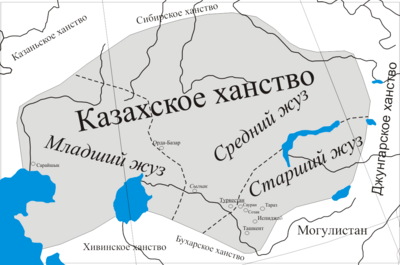| Third invasion of the Kazakh Khanate | |||||||
|---|---|---|---|---|---|---|---|
| Part of Kazakh-Uzbek Wars | |||||||
 Kazakh Khanate Maximum Extent in 1520 CE | |||||||
| |||||||
| Belligerents | |||||||
|
| Kazakh Khanate | ||||||
| Commanders and leaders | |||||||
|
|
Kasym Khan Buyun Pir Hasan | ||||||
| Campaigns of Muhammad Shaybani | |
|---|---|
In the year 1509, Shaybani Khan proceeded against the Kazakhs. At that time, although the Khan of the Kazakhs was, Burunduk Khan, yet all the business of government was conducted by Kasym Khan Qasim Beg, son of the late Khan, Janybek Khan. In spite of his great power, Shaybani Khan had not force enough to withstand Kasym Khan. At that period, the numbers of his army exceeded 20,000. In winter time every one stayed in some place where there was fodder for the cattle. In the middle of the winter, Shaybani Khan was engaged in plundering Kazakh territories, but he soon returned, his object being not to remain too far from his own country. Shaybani Khan made his last expedition into Kazakh territory, but the strength of his horses and soldiers was quite exhausted; he himself remained in the district of Kuk Kashana, and having detached a force, whose horses had some strength left, sent them forward. This party fell in with a few men, whom they despoiled and made prisoners. One day this same party had halted for the sake of feeding their horses, when news came that Qasim Khan, Qasim Beg was close at hand. This news alarmed them. Buyun Pir Hasan, one of Kasym Khan's Amirs, having heard of the invasion of the Uzbeks, advanced against them with his own army; he spread the report that Kasym Khan was approaching and had let himself be seen in the distance. The Uzbeks being fully persuaded that Qasim Khan was really upon them, abandoned all they had seized, even all they had brought with them and retreated, in the utmost disorder and confusion, to Shaybani Khan, bearing the news of Kasym Khan's approach. Shaybani Khan at once ordered them to sound the drum of retreat, without paying attention to anything but getting away. The Uzbek army retreated in disorder for the first time in their military career since the advent of Shaybani Khan and reached Samarkand at the end of the winter. Shaybani Khan himself went on to Khorasan, where he spent the spring.
References
- А. Кузембайулы, Е. Абиль: История Казахстана, с. 110
- ^ Mirza Muhammad Haidar Dughlat, N. Elias, Sir Edward Denison Ross (31 Dec 2008). A History of the Moghuls of Central Asia: The Tarikh-i-Rashidi. Cosimo, Inc. p. 696. ISBN 9781605201504. Retrieved 2012-11-23.
{{cite book}}: CS1 maint: multiple names: authors list (link) - ^ René Grousset (1970). The Empire of the Steppes:A History of Central Asia. Rutgers University Press. p. 687. ISBN 0813513049. Retrieved 2012-11-23.
Sources
- Tarikh-i-Rashidi - A History of the Moghuls of Central Asia